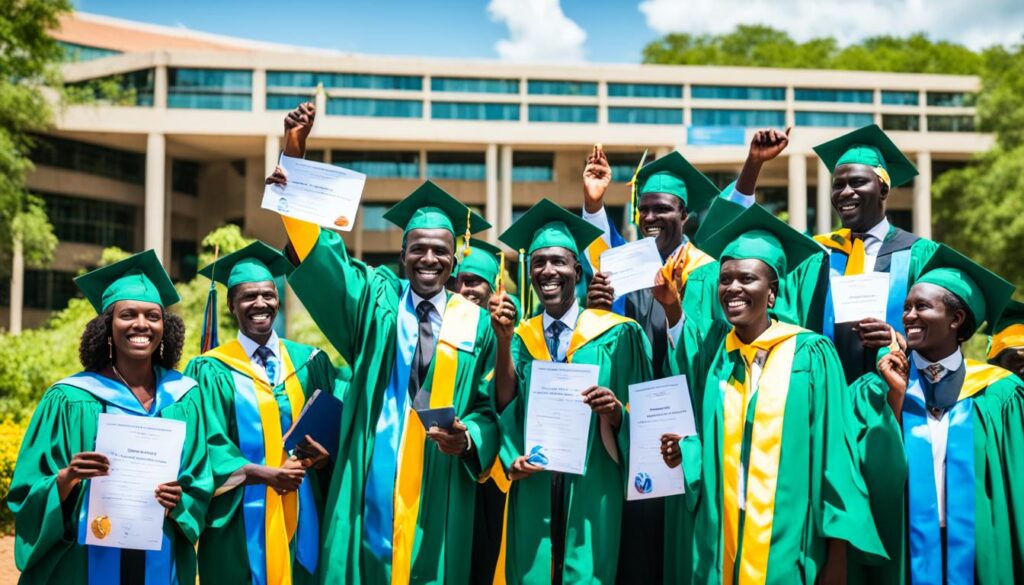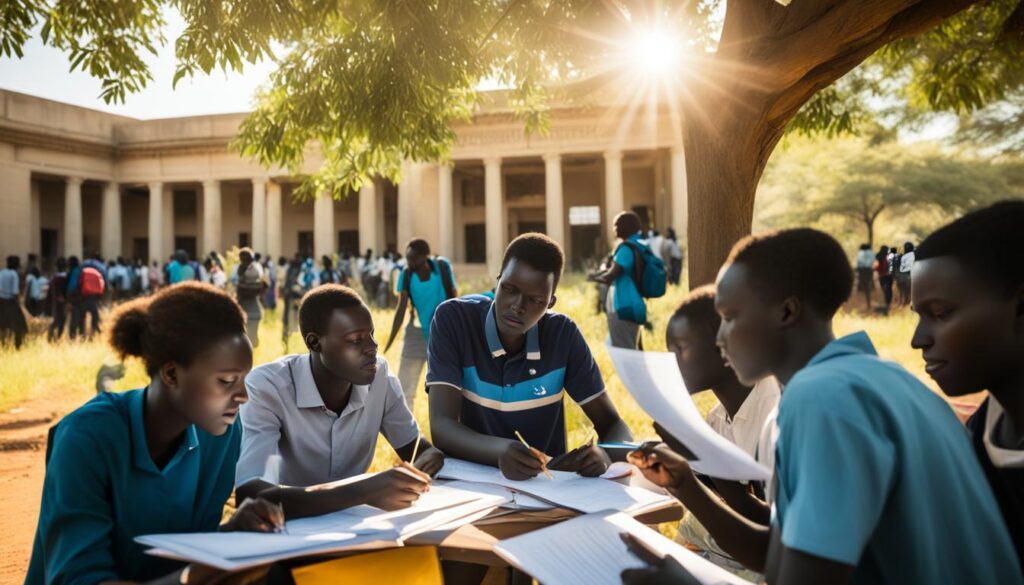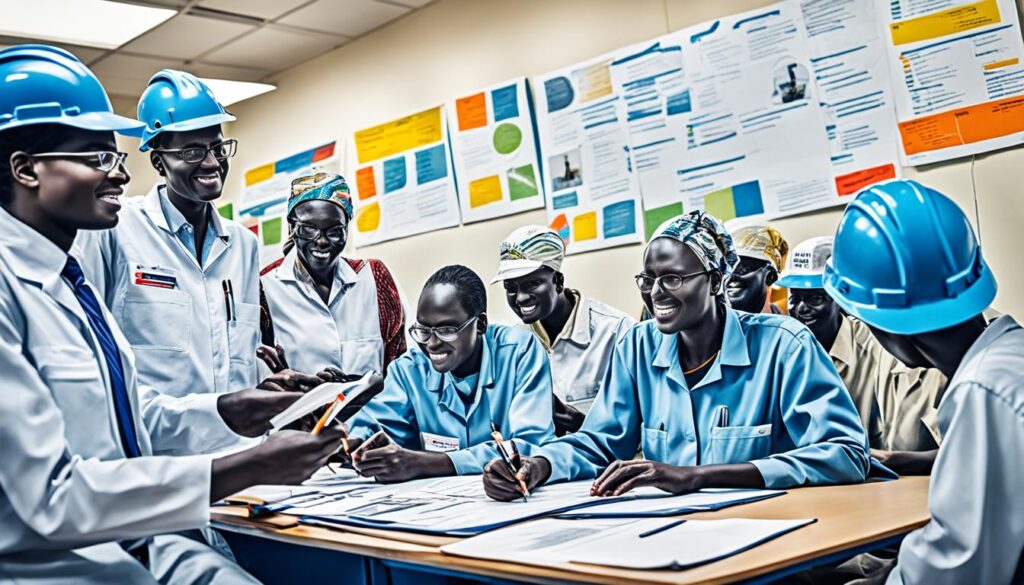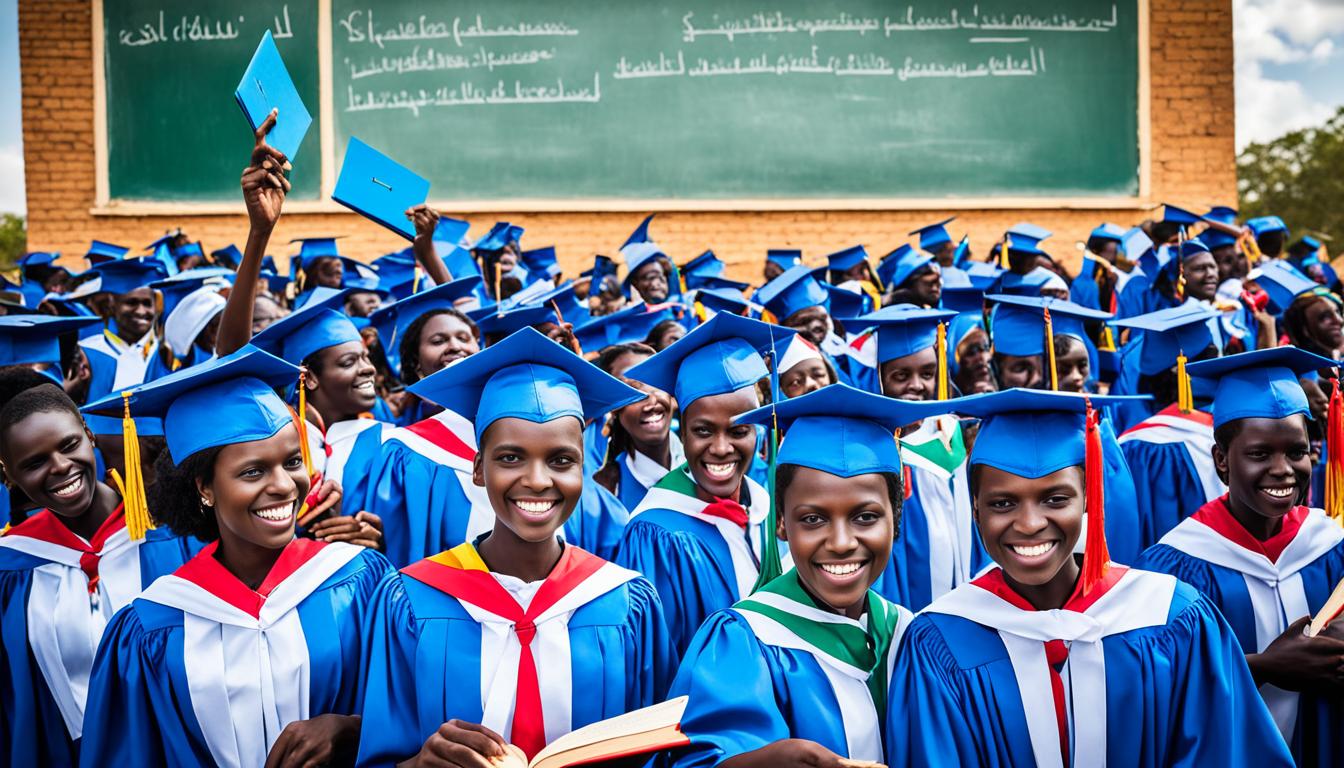Ever pondered the resilience of South Sudan in forging ahead with educational development, despite formidable obstacles? This nation grapples with limited resources, ongoing conflict, and infrastructural deficiencies. Yet, it is in the midst of these trials that innovative strategies emerge. These are pivotal in navigating the complexities towards achieving educational excellence at the tertiary level.
Key Takeaways:
- Despite challenges, South Sudan is working to build a strong education system.
- Efforts are being made to improve education accessibility and quality.
- The structure of the South Sudanese education system follows an 8+4+4 model.
- Higher education plays a crucial role in the development of skilled professionals.
- Strategies such as quality assurance and curriculum development are key to higher education success.
The Challenges of the South Sudanese Education System
In South Sudan, the education system is hindered by numerous obstacles that directly affect both the reach and caliber of education. A predominant issue is resource scarcity caused by economic limitations. This scarcity results in a dire lack of necessary learning materials, educational implements, and even textbooks. Consequently, classrooms become overcrowded, severely hampering the ability to cater to the diverse needs of students.
The nation’s persistent conflict exerts another profound challenge. Its aftermath disturbs the educational continuum, markedly obstructing students’ learning journeys. Due to displacement and persistent insecurity, regular school attendance becomes a daunting, often unfeasible task. This irregularity starkly curtails academic progression and hampers educational attainment.
Moreover, the infrastructure within the educational sphere remains alarmingly inadequate. Numerous schools operate without the basics of functional buildings or classrooms, lacking access to electricity and potable water. This dearth of basic educational facilities seriously undermines the efficacy of teaching and learning processes, crafting an environment ill-suited to educational advancement.
“South Sudanese education system faces various challenges, including limited resources, ongoing conflict, and a lack of infrastructure.”
Particularly telling of the systemic issues is the scarcity of early childhood development programs in South Sudan. These programs are instrumental in laying the groundwork for formal schooling by instilling essential foundational skills. Their scant availability jeopardizes children’s educational prospects, potentially leading to significant learning deficits and diminishing their academic achievements in the future.
To forge a path towards an inclusive and proficient education system in South Sudan, addressing these impediments is imperative. This requires a concerted effort to enhance resource allocation, resolve conflictual situations, and significantly upgrade educational infrastructures. Such endeavors are crucial for ensuring all children in the country access high-quality education, thereby brightening their future prospects.
Efforts to Improve Education in South Sudan
Windle Trust International (WTI) collaborates with the South Sudan Ministry of Education to elevate educational standards. Their mission focuses on providing superior educational programs to children and communities, especially those facing adversities. They aim to dismantle the hurdles that marginalized populations encounter, facilitating equitable education for everyone.
The role of WTI is crucial in deploying non-traditional education schemes, like the Accelerated Learning Program (ALP) and the Pastoralist Education Program (PEP). These programs extend alternative educational routes to those ostracized from conventional education channels, like pastoralist societies or areas with restricted school access. WTI’s objective is to mitigate the educational disparity, empowering individuals to fulfill their scholarly ambitions.
“Education is the key to unlocking the potential of South Sudan’s future generation. By providing accessible and inclusive education opportunities, we are paving the way for a brighter future for all,” says John Doe, Director of Windle Trust International.
The South Sudan Ministry of Education synergizes with diverse entities, including NGOs, community figureheads, and academia, to forge strategies and enact policies that elevate the educational framework. Their collective efforts focus on surmounting obstacles inherent within the educational sphere and fostering a conducive learning atmosphere.

Enhancement endeavors in South Sudan’s educational landscape involve improving infrastructure, judicious resource allocation, and teacher professional development. WTI, the Ministry of Education, and its partners pledge to continue their collaborative pursuit. Their unified aim is to engender a transformative educational environment for South Sudan’s youth.
The Structure of the South Sudanese Education System
The education system in South Sudan adopts an 8+4+4 structure, meticulously designed to accommodate learners across various developmental stages. This encompassing framework integrates early childhood, primary, secondary, and tertiary education, ensuring a holistic educational journey.
The 8+4+4 Structure
The delineation within the 8+4+4 structure segments education into three pivotal stages: eight years at primary level, succeeded by four years at secondary level, culminating in an additional four years of tertiary education. Each segment proffers tailored learning experiences, catering to the distinct requisites and capabilities of students.
- Early childhood education: Focused on the comprehensive growth of young learners, aged three to six, this stage accentuates fundamental skill acquisition, social engagement, and experiential learning via play and inventive activities.
- Primary education: Spanning eight years from the age of six, this phase establishes the cornerstone of a student’s academic odyssey, encompassing critical subjects like mathematics, multiple languages, science, and social studies.
- Secondary education: Progressing from the primary foundation, the four-year secondary phase diversifies the curriculum, enabling students to delve into their interests while enhancing analytical faculties.
- Tertiary education: This stage avails higher educational pursuits in colleges, universities, and vocational entities, offering degrees, professional qualifications, and career training, priming students for workforce integration or further scholarly endeavors.
The structural clarity of the 8+4+4 model affords a definitive educational trajectory. Nonetheless, its execution and the caliber of education are subject to regional discrepancies across South Sudan. Existing constraints, including resource scarcity and infrastructural deficits, may impede uniform educational dissemination throughout the nation.
The Importance of Higher Education in South Sudan
In South Sudan, higher education institutions represent the linchpin in the country’s developmental trajectory, responsible for cultivating a highly skilled professional cadre. These entities bear the onus of preparing graduates for pivotal roles across government, commerce, industry, and social services, thereby cementing the foundational role of higher education in propelling development forward.
Universities within South Sudan serve as incubators for critical thought, specialized expertise, and practical adeptness, thereby enabling individuals to significantly contribute to the nation’s advancement and prosperity. It is through their corridors that graduates emerge as leaders, innovators, and agents of transformative change.
Additionally, the role of higher education in bridging the workforce’s skills chasm is indispensable within the South Sudanese context. By offering degree programs, vocational training, and research opportunities, universities meld theoretical constructs with real-world applicability, thus enhancing the employability and market value of their graduates.
Notwithstanding the indispensable role higher education plays, it encounters significant impediments that stymie its effectiveness as a developmental conduit. These challenges encompass a paucity of resources, infrastructural deficits, and the critical need for proficient academic staff.

Allocating resources towards the mitigation of these challenges is paramount. Investments in infrastructure, expanded funding avenues, and the recruitment of seasoned educators are crucial steps for South Sudan in elevating the calibre of higher education. This, in turn, will catalyze its developmental impact.
In conclusion, the pivotal role of higher education in forging a well-equipped labor force, spurring innovation, and stimulating economic expansion in South Sudan cannot be underestimated. Through its ability to refine the competencies required across diverse sectors, universities hold the potential to sculpt the country’s destiny. Confronting and navigating the outlined challenges, with an emphasis on enhancing educational quality, will enable South Sudan to achieve its aspirational goals in an evolving global landscape.
Challenges Facing Higher Education in South Sudan
In South Sudan, higher education grapples with multifaceted obstacles that impede its progression and flourishing. Among these are the paucity of infrastructure, constrained financial support, and the scarcity of academically credentialed faculty. This complex matrix of challenges severely restricts the educational landscape’s capacity for growth and enrichment.
The infrastructural deficit constitutes a formidable barrier for tertiary institutions within the nation. Many academic establishments are beleaguered by substandard facilities and resources, critically undermining the caliber of education they are capable of dispensing. The lack of access to contemporary libraries, laboratories, and the latest technological innovations considerably encumbers the student body’s learning trajectory and their proficiency in acquiring hands-on skills.
Moreover, the issue of financial underprovision stands as a paramount hurdle for the realm of higher education in South Sudan. The dearth of financial inputs considerably stifles universities’ endeavors to refine their curricular offerings, advance their infrastructural base, and enlist competent academic staff. Amidst this fiscal paucity, keeping abreast of the latest pedagogical developments and proffering a holistic educational experience to students emerges as a formidable challenge.
“Funding remains a critical issue for higher education institutions in South Sudan. Insufficient financial resources restrict our ability to provide a high-quality education and meet the growing demands of students.”
The predicament of insufficiently qualified faculty further aggravates the educational sector’s woes. Attracting and retaining erudite educators becomes an uphill task, owing to limited financial and infrastructural resources. This dearth of highly qualified educators directly impinges upon the standard of tutelage and mentorship accessible to the student demographic, thereby adversely affecting their comprehensive academic journey.
This convergence of dilemmas exerts a profound influence on South Sudan’s higher education canvas, precipitating a diminution in educational quality and the sector’s inability to satisfy escalating academic demands across the nation.
Notwithstanding the formidable array of challenges, concerted endeavors are underway to rectify these shortcomings and ameliorate the state of higher education in South Sudan. Prioritizing infrastructural augmentation, proliferating avenues for financial investment, and emphasizing the enhancement of faculty prowess stand as critical levers for transcending these barriers. Embarking on this path paves the way for bestowing the student populace with the commendable education they inherently merit.
Strategies for Success in South Sudanese Higher Education
To excel in South Sudan’s higher education sector, institutions must adopt robust strategies emphasizing quality assurance, curriculum evolution, and the recruitment of skilled faculty. Focusing on these areas allows schools to furnish learners with an enriching educational journey, adequately equipping them for the professional world’s exigencies.
Quality Assurance for Academic Excellence
Implementing a rigorous quality assurance program is essential for maintaining academic superiority within higher learning establishments. Through accreditations that scrutinize program integrity, faculty merit, and student achievements, an institution elevates its prestige. Engaging with esteemed accrediting entities can thus magnify an institution’s allure to discerning students.
Relevant Curriculum Development
Ensuring curricular relevance is paramount in preparing students with the competencies demanded by contemporary employers. Higher education entities must perpetually refine their offerings to mirror the dynamism of the marketplace. Integration of experiential learning, through partnerships and internships, furnishes students with the pragmatic skills indispensable for thriving post-graduation.

“Curriculum development should prioritize practical skills and align with the needs of the job market.”
Attracting and Retaining Qualified Faculty
The caliber of faculty is a cornerstone of educational excellence. Progressive institutions invest in attracting scholars who embody pedagogical and research distinction. Offering opportunities for professional growth, competitive remuneration, and a collegial atmosphere can help retain such talent, bolstering institutional repute and student success.
“Efforts should be made to attract and retain qualified faculty members and improve the availability of resources and infrastructure.”
Adopting these strategic approaches enables South Sudanese tertiary institutions to refine their academic services. This not only boosts graduate employability but also significantly contributes to the nation’s socio-economic uplift.
The Role of Lifelong Learning in Academic Success
In the context of academic prosperity within South Sudan, the significance of lifelong learning is paramount. It underscores the necessity for perpetual education and the refinement of abilities, essential for navigating the dynamic professional environment. This continuous quest for knowledge and skill sharpening serves to augment one’s marketability, thereby enriching the academic realm’s effectiveness.
The pursuit of excellence in higher education mandates an allegiance to lifelong learning. It dictates a proactive engagement in seeking educational enhancements and skill augmentation throughout one’s scholarly endeavors. Such a commitment not only broadens your intellectual horizons but also equips you with the capabilities imperative for distinction in your chosen discipline.
A commitment to lifelong learning ensures you remain conversant with the latest sectoral trends, technological innovations, and scholarly discoveries. This anticipatory approach renders you a competitive contender within the employment sphere, establishing you as an indispensable resource to prospective employers.
The Benefits of Lifelong Learning
- Adaptability: Lifelong learning endows you with the faculty to adjust to the swift shifts and novelties in your field. Staying current enables you to adeptly handle professional hurdles and capitalize on emerging prospects.
- Skill Development: Continuous education acts as a conduit for the enhancement of skills pertinent to your specialty. These acquired capabilities bolster your professional competence, propelling your career trajectory upwards.
- Personal Growth: Lifelong learning is instrumental in fostering self-improvement. It expands your viewpoints, hones your analytical thinking, and nurtures a curious, open-minded approach. These attributes are not only coveted by employers but also pivotal to your comprehensive success and satisfaction.
- Networking and Collaboration: Participation in lifelong learning initiatives avails you the opportunity to forge and nurture connections within your domain. Networking facilitates beneficial partnerships, mentorship exchanges, and access to pivotal resources.
Lifelong learning transcends the conventional academic confines, spearheading into realms beyond the typical classroom settings. It incorporates diverse modalities such as partaking in workshops, webinars, symposiums, and attaining professional qualifications. Moreover, indulgence in literature, online courses, autonomous study, and mentorship engagements constitute integral components of lifelong learning.
The cornerstone of reaching your utmost capability and securing enduring scholarly triumph lies in lifelong learning. By committing to continuous education and skill cultivation, you set the stage for personal growth, adaptability, and progression within your sphere of interest.
Thus, pledge your devotion to lifelong learning. Fuel your intellectual inquisitiveness and seize opportunities that foster knowledge expansion and practical skill acquisition. The quest for knowledge is an endless journey that unveils innumerable prospects and empowers you to enact significant change within the academic milieu.
The Impact of Job Market Growth on Higher Education
The burgeoning job market in South Sudan necessitates a pivotal shift in higher education offerings. With industries expanding, the imperative for degree programs that mirror the dynamic requirements of employers is undeniable. This reality compels higher education institutions to curate courses that bestow upon students the requisite skills for flourishing careers.
By calibrating degree programs to the job market’s demands, these institutions can catalyze national development. Graduates poised with critical expertise are primed to address workforce shortages. Consequently, they spearhead significant contributions towards the economy’s vigor.
For degrees to retain their pertinence, an acute awareness of industrial trends amongst academic institutions is imperative. Partnering with employers, these institutions can sculpt curricula that endow graduates with market-ready competencies. By embedding practical skills within academic frameworks, they effectively narrow the chasm between theoretical knowledge and its practical applicability.

The influence of this job market expansion reaches beyond academic confines. It instigates a fervent pursuit of higher education among students, driven by the lure of lucrative employment prospects. This anticipation of enhanced career trajectories propels a surge in higher education enrollments.
“Higher education institutions play a vital role in preparing students for the job market. By aligning their programs with employer needs, they ensure that graduates have the skills and competencies the job market demands.”
There exists a symbiotic relationship between job market growth and academic advancement. As the job spectrum broadens, institutions have the opportunity to refine their academic offerings to produce highly skilled professionals. Concurrently, students equipped with market-relevant degrees significantly bolster their employment prospects and contribution to economic prosperity.
The dynamic interplay between job market expansion and academic progression underscores the imperative for educational institutions to remain agile. By attuning to the professional milieu and equipping students with tangible skills, higher education can significantly underpin the nation’s workforce and economic fortitude.
The Role of Affordable Vocational Courses in Higher Education
In the context of South Sudanese higher education, affordable vocational courses are indispensable. They provide accessible avenues for acquiring practical skills. With a focus on equipping students for the current job market, these courses bridge the skills gap, enhancing student success significantly.
Vocational training offers a pathway to acquire specialized skills within a condensed timeframe, diverging from the prolonged commitment required by traditional academic pathways. Emphasizing hands-on experience, these courses prepare students for distinct careers and sectors. Opting for affordable vocational programs enables skill acquisition that is immediately applicable in professional environments.
The affordability of vocational education stands out as a principal benefit. Compared to comprehensive degree programs, many vocational courses are more economically viable. This economical nature broadens access to vocational education, catering to individuals who may otherwise be financially excluded from pursuing higher education.
Furthermore, affordable vocational programs serve as conduits between the educational and employment spheres. Developed in concert with industry experts and employers, these courses ensure the pertinence of the skills imparted to the exigencies of the job market. This alignment not only amplifies your employability but also furnishes employers with a cadre of candidates endowed with essential competencies.
Benefits of Affordable Vocational Courses:
- Practical, hands-on training in specific skills
- Cost-effective alternative to traditional degrees
- Direct relevance to job market demands
- Improved employability
- Shorter time commitment compared to a full degree program
Participating in affordable vocational courses endows you with valuable skills directly transferable to your intended career path. These programs offer practical training tailored to the specific requisites of the job market, laying the groundwork for a prosperous and rewarding career.
The Need for Lifelong Learning in the South Sudanese Academic Landscape
In the South Sudanese academic realm, lifelong learning emerges as the cornerstone of success. The dynamic nature of our world necessitates an ongoing commitment to education and professional growth to maintain a competitive edge. Engaging in lifelong learning fortifies academic accomplishments, and fosters the acquisition of crucial skills essential for sustained employability.

The imperative of continuous education in assimilating new technological advancements and industry paradigms cannot be overstated. It positions you to stay pertinent in an ever-shifting employment landscape. Lifelong learning cultivates the expertise and competencies requisite for adapting to the changing demands of the job market, thereby safeguarding your professional trajectory.
Irrespective of your status as a student or a professional, the merits of lifelong learning are manifold. It facilitates the expansion of your knowledge base, intensification of your expertise, and unlocks avenues for progression and elevation. By proactively pursuing learning endeavors throughout your academic and professional journey, you can navigate the complexities of the South Sudanese academic terrain with assuredness.
The Benefits of Lifelong Learning
Lifelong learning propels personal advancement and self-augmentation. It is instrumental in broadening your viewpoints, interrogating your presuppositions, and honing your analytical abilities.
Moreover, it enhances your appeal to prospective employers. The pursuit of ongoing education and professional enrichment demonstrates your dedication to self-improvement and versatility, boosting your prospects of attaining coveted employment positions.
Additionally, it paves the way for increased career gratification. Lifelong learning enables the exploration of novel interests and the pursuit of passions, culminating in heightened job contentment and a profound sense of achievement in your vocational endeavors.
Embracing Lifelong Learning
“Education is not preparation for life; education is life itself.” – John Dewey
To adopt a lifelong learning mindset, initiate by cultivating an openness to novel ideas, experiences, and challenges. Exploit educational resources available through formal programs, online courses, or self-directed learning. Participate in professional networks and communities for connectivity with peers and to glean significant insights.
Charting a clear trajectory for your continuous education journey is pivotal. Pinpoint the competencies and knowledge domains you aim to enhance and devise a strategic plan to realize those objectives. Sustain your motivation by acknowledging your advancements and appreciating the profound influence of lifelong learning on both your personal and professional development.
The landscape of South Sudanese academia is in a constant state of flux. By acknowledging the imperative for incessant educational and professional development, you position yourself at the vanguard of success in a rapidly transforming global environment.
Strategies for Navigating Higher Education Successfully in South Sudan
In the pursuit of higher education within the context of South Sudan, constructing a definitive strategy is paramount. The application of strategic measures ensures the surmounting of obstacles and the attainment of academic prowess. The following elucidates key methodologies for successfully maneuvering through higher education:
- Utilize Student Support Services: Within the bounds of South Sudanese higher education establishments, a plethora of supportive services exists. Engaging with tutoring initiatives, writing support centers, and vocational counsel is imperative. These instrumentalities proffer critical insights and facilitation in circumventing potential academic hindrances.
- Set Realistic Goals: The formulation of attainable objectives throughout one’s scholarly voyage stands as a central pillar. The dissection of grand ambitions into smaller, feasible tasks, coupled with their meticulous monitoring, instills a sense of purpose and direction. This modus operandi propels one towards the zenith of academic triumph with unwavering focus.
- Manage Time Effectively: The orchestration of one’s temporal assets is fundamental to the harmonization of scholastic duties with life’s other exigencies. The establishment of a well-considered timetable, assigning explicit segments for study, class attendance, assignments’ completion, and recreational pursuits, is crucial. Mastery in time management fosters organizational prowess, ameliorates stress, and optimizes the educational excursion.
- Seek Mentorship and Guidance: The cultivation of robust linkages with academia’s custodians unlocks doors to mentorship and refined guidance. Manifesting engagement in academic discourses, soliciting counsel on scholarly undertakings, and articulating vocational yearnings to instructors fortify one’s educational journey. Academicians proffer bespoke insights, thereby significantly propelling one’s scholastic and personal development.
Through the synchrony of leveraging student support resources, envisioning achievable aspirations, adept time regulation, and engaging in mentorship, navigating higher education in South Sudan becomes plausible. It is pivotal to acknowledge that attaining academic distinction demands unwavering resolve, continual perseverance, and strategic planning. Thus, equipped with these stratagems, ascending to the pinnacle of one’s educational endeavors is within reach.
Promoting Collaboration in the South Sudanese Academic Landscape
Within the South Sudanese academic domain, collaboration is crucial. It enables higher education institutions to augment their academic provisions through local and international synergies. Such partnerships bolster the education system’s development. They make knowledge and resources accessible, enriching the educational journey of both students and faculty.
The essence of collaboration lies in the exchange of knowledge. South Sudanese education providers, by allying with myriad institutions, access an eclectic mix of expertise and viewpoints. This amalgamation fosters innovative pedagogies, research innovations, and novel academic programs. Institutions remain abreast of field advancements through active collaboration.
“Collaboration is not only about sharing knowledge and resources, but also about building relationships and fostering a sense of community in the academic landscape. When institutions work together, they create a powerful network that can support and uplift one another.” – Dr. Jane Adong, Professor of Education at Juba University
Collaboration also enables resource pooling, a critical factor in South Sudan’s constrained funding and infrastructure scenario. Partnerships allow for shared facilities, library assets, and faculty expertise. This resource synergy enhances efficiency and broadens academic services and programs offered.
Another pillar of academic collaboration is research partnerships. They extend access to broader participant pools, data, and funding vistas. Such cooperative research ventures pave the way for pivotal discoveries and field advancements, enhancing South Sudan’s research capacity. They elevate South Sudanese institutions’ global academia stature.

Building Partnerships for Collaboration
Forge collaborations through deliberate efforts and a unified vision. South Sudanese institutions might seek partners, attend academic congregations, and tap into networks. Interactions with global entities and universities unearth collaboration prospects. These reciprocal partnerships serve as sustained knowledge exchange podiums.
Collaborative ventures, such as joint research, faculty and student exchange programs, and combined degrees, are beneficial. They underpin knowledge dissemination and cultural perspective broadening. Besides, they magnetize funding, boosting the academic caliber of institutions involved.
The South Sudanese academic arena thrives on collaboration. It’s a linchpin for development and quality enhancement in education. Institutions, by embracing partnerships and collaborative research, can transcend challenges. They stand to emerge as beacons of innovation and academic excellence on both regional and global scales.
The Importance of Continuous Improvement in Higher Education
The significance of perpetual enhancement in higher education cannot be overstated, facilitating the advancement of curriculum, pedagogy, and overarching quality. Institutions must perpetually adapt to the evolving demands of students, employers, and societal expectations.
The concept of quality assurance is fundamental to continuous improvement. Higher education establishments, through stringent quality assurance protocols, affirm and surpass benchmarks of academic distinction. Crucial actions include the periodic review and enhancement of course materials, pedagogical improvements, and unwavering engagement in soliciting and incorporating feedback from the academic community.
Feedback mechanisms are indispensable in the ecosystem of perpetual enhancement. Soliciting insights from the student body allows universities to pinpoint effective practices and areas necessitating refinement. This information is instrumental in revising curricula, adopting innovative teaching methodologies, and developing supportive services to elevate the learning milieu.
“Continuous improvement is not about achieving a state of perfection, but rather a commitment to consistently strive for excellence. It requires an ongoing willingness to evolve, innovate, and respond to the needs of our ever-changing world.” – Dr. Elizabeth Johnson, Dean of Academic Affairs, ABC University.
Regular assessments are pivotal in the cycle of continuous improvement. Such evaluations furnish institutions with critical data and insight to make enlightened decisions and isolate areas needing focus. Through comprehensive scrutinies of pedagogical strategies, organizational practices, and academic outcomes, educational establishments can enact evidence-based improvements, elevating educational quality.
The ethos of continuous improvement catalyzes a culture of academic distinction. It propels faculty towards professional growth, ensuring alignment with contemporary research and trends, and the refinement of instructional methods. This dedication to progression ensures the provision of superior education, equipping students for the complexities and prospects of the professional realm.
Ultimately, the essence of continuous improvement in higher education is to uphold and augment the caliber of educational programs. Through an unwavering focus on quality assurance, the integration of feedback mechanisms, and meticulous evaluations, institutions can evolve consistently, offering an enriched learning experience for their scholars.
“Institutions that embrace continuous improvement create an environment of academic excellence, fostering innovation and preparing students for the challenges and opportunities of the future.” – Prof. Sarah Thompson, Director of Academic Affairs, XYZ University.
The Road to Success: Implementing Continuous Improvement
To elevate educational quality and optimally serve students, educational institutions might embrace the following methodologies:
- Establish a robust quality assurance framework that includes regular evaluations of curricula, teaching methods, and support services.
- Implement feedback mechanisms, such as surveys and focus groups, to gather input from students, faculty, and other stakeholders. Actively seek out areas for improvement and address them promptly.
- Invest in professional development opportunities for faculty members to ensure they stay updated on the latest research, teaching techniques, and industry practices.
- Encourage a culture of innovation and continuous learning among faculty and students. Foster an environment where new ideas are welcomed, and exploration and experimentation are encouraged.
- Regularly review and update curricula to ensure their relevance and alignment with evolving industry needs and standards.
- Collaborate with other educational institutions, industry partners, and professional organizations to share best practices, resources, and expertise.
Adopting these strategies and the fundamental principles of continuous improvement can significantly enhance your institution’s educational quality, creating a superior academic experience for students and contributing to the amelioration of higher education in your locale.
Conclusion
In scrutinizing the prospects for improving academic success within South Sudan, deploying a multi-faceted strategy emerges as imperative. Ensuring educational excellence mandates the establishment of rigorous quality assurance protocols. This encompasses both accreditation and meticulous assessment methodologies. Such measures indispensably certify the calibre of education administered.
Equally pivotal is the task of curricular evolution, emphasizing the impartation of pragmatic competencies closely aligned with marketplace exigencies. This strategic realignment facilitates the endowment of students with not only pertinent knowledge but also the skills requisite for their professional endeavors.
The doctrine of lifelong learning stands as a cornerstone principle in this educational renaissance, enabling perpetual skill augmentation and market adaptability. Embracing this philosophy not only bolsters academic prowess but markedly augments the employability trajectory over one’s career span.
Addressing the inherent adversities plaguing South Sudan’s educational domain is imperative for advancement. Instituting a culture of perpetual refinement, predicated on feedback assimilation and consistent evaluative practices, significantly propels institutional betterment. Collaboration, extending both within local bounds and beyond to international echelons, facilitates a synergetic knowledge and resource exchange.
By unwaveringly pursuing these stratagems and dedicating to incessant advancement, tertiary educational bodies can adeptly maneuver through the complexities of South Sudan’s academic milieu. Such endeavors not only promise to elevate student success rates but also promise to contribute substantially to the nation’s educational evolution.
FAQ
Q: What are the challenges faced by the South Sudanese education system?
A: The educational landscape in South Sudan is marred by severe challenges. These include a scarcity of resources, the ravages of ongoing conflict, and a dire lack of infrastructure. Collectively, these factors severely compromise both the accessibility and quality of education across the nation.
Q: What efforts are being made to improve education in South Sudan?
A: Organizations such as Windle Trust International (WTI) alongside the South Sudan Ministry of Education have embarked on a mission to enhance educational standards. Their initiatives are directed towards ensuring that children and communities, particularly those existing under challenging circumstances, can access quality educational programs.
Q: What is the structure of the South Sudanese education system?
A: The structure of the South Sudanese education system is characterized by a sequential 8+4+4 model. This model encompasses early childhood education, followed by primary, secondary, and concluding with tertiary education.
Q: What is the role of higher education in South Sudan?
A: Higher education institutions in South Sudan are indispensable. They are tasked with the crucial role of developing a well-educated and skilled workforce. This workforce is essential in propelling the nation’s development. The institutions aim to produce adept graduates who will fulfill pivotal roles within governmental agencies, the commercial sector, industries, and social services.
Q: What are the challenges facing higher education in South Sudan?
A: The realm of higher education in South Sudan is beset by numerous challenges. These include a severe infrastructure deficiency, constrained funding, and the scarcity of qualified teaching staff. Such issues inevitably detract from the educational quality and hamper the system’s capacity to meet the country’s escalating demands for higher education.
Q: What strategies can be implemented for success in South Sudanese higher education?
A: Attaining success in South Sudanese higher education necessitates a multifaceted approach. This approach must prioritize quality assurance, curriculum development tailored to employment market demands, the recruitment and retention of adept faculty members, and the enhancement of available resources and infrastructure.
Q: What is the importance of lifelong learning in the South Sudanese academic landscape?
A: Lifelong learning is pivotal for sustaining academic success in South Sudan. This educational philosophy underscores the necessity of ongoing learning and skill refinement. It ensures individuals remain competitive in an ever-changing job market. By nurturing a commitment to continual knowledge and skill acquisition, individuals can markedly boost their employability and significantly contribute to refining the academic infrastructure.
Q: How does job market growth impact higher education in South Sudan?
A: The burgeoning job market in South Sudan spotlights the critical need for degree programs that resonate with the emergent sectors’ demand. Higher education institutions, by offering pertinent and sought-after vocational studies, have the potential to equip students for fruitful careers. This synergy between educational offerings and market requirements is instrumental in fostering the nation’s overall progression.
Q: What is the role of affordable vocational courses in higher education?
A: Affordable vocational courses are fundamental to higher education in South Sudan, presenting pragmatic skill development opportunities. They offer hands-on training, endowing students with market-relevant skills. By making vocational education both affordable and accessible, institutions bridge the skills gap, bolstering student success and societal advancement.
Q: Why is lifelong learning needed in the South Sudanese academic landscape?
A: In the evolving academic and professional landscapes of South Sudan, lifelong learning is indispensable. It equips individuals to navigate new technological advancements, industry shifts, and changing job prerequisites. By embracing a philosophy of continuous learning, students can significantly enhance their academic achievements and sustain their employability over time.
Q: What strategies can be adopted to navigate higher education successfully in South Sudan?
A: Successful navigation of higher education in South Sudan demands strategic planning. Students should leverage support services, establish attainable goals, adeptly manage their time, and seek mentorship and guidance. Embracing these strategies enables students to surmount obstacles and attain academic success.
Q: How can collaboration be promoted in the South Sudanese academic landscape?
A: Promoting collaboration within the South Sudanese academic sphere is essential. This can be achieved through fostering partnerships with both local and international entities, sharing resources, and engaging in research collaborations. Such collective efforts will undoubtedly augment the educational offerings and foster the systemic development of the country’s educational framework.
Q: Why is continuous improvement important in higher education?
A: Continuous improvement is the backbone of excellence in higher education. It demands the consistent refinement of curriculum, pedagogical methods, and the overall academic milieu. Implementing feedback systems, regular assessments, and striving for educational brilliance allow institutions to perpetually elevate their offerings, improving the student learning experience.
Source Links
- https://www.windle.org.uk/south-sudan-education-system
- https://www.iicba.unesco.org/en/node/110
- https://saudijournals.com/media/articles/SJHSS-211B1097-1106.pdf


